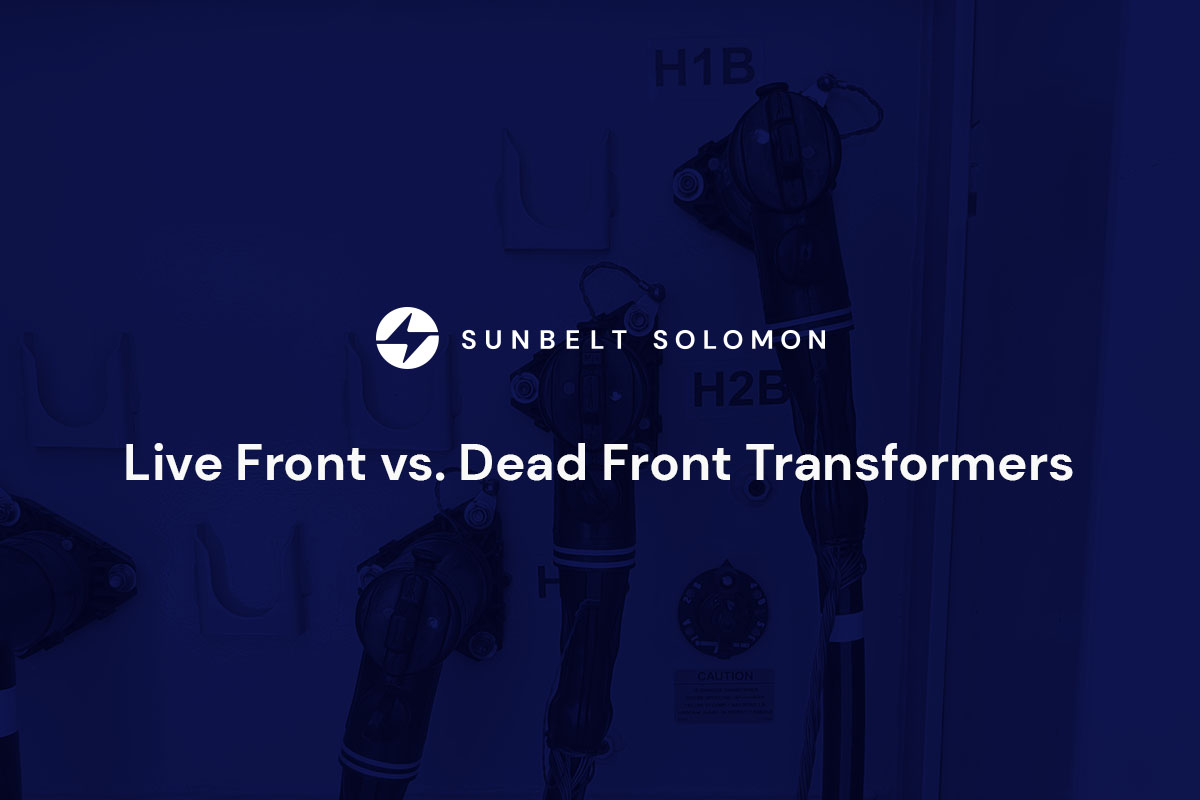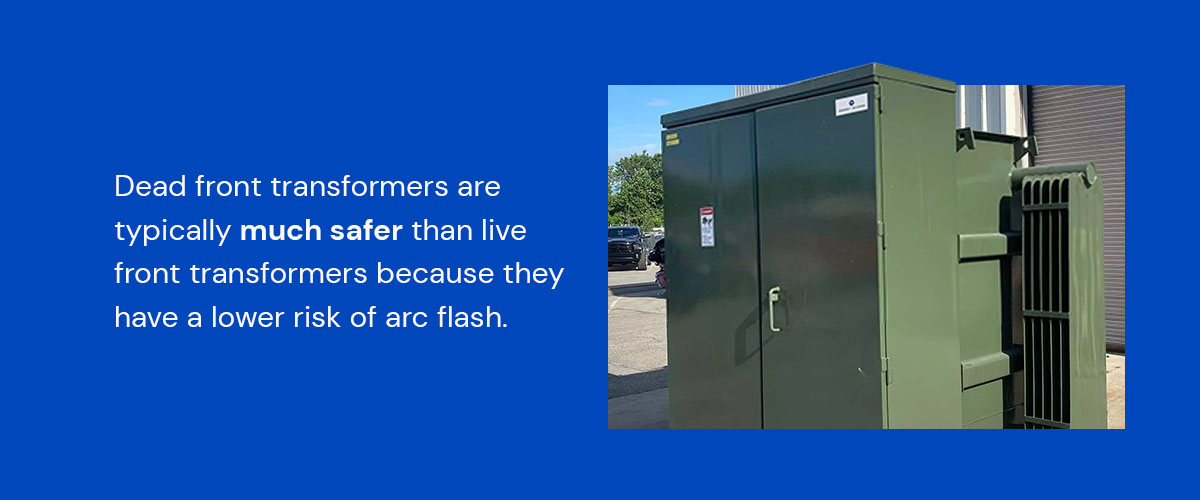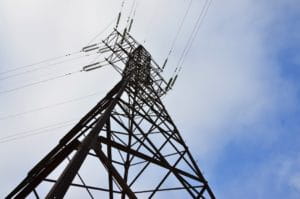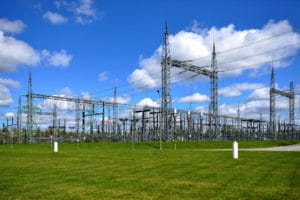
Understanding the differences between transformers enables you to choose the right option for each application. Live front transformers are useful for controlled access areas and temporary applications, but dead front transformers are becoming more widespread due to their higher level of safety.
What Is the Difference Between Live Front and Dead Front Transformers?
The main difference between a live front and dead front pad-mounted transformer is the bushing’s components and safety. The bushing is the transformer’s insulating structure that transfers an electrical current from the transformer’s grounded tank to outside the transformer. An electrical current passes through the transformer, and the bushing protects it from nearby conductive materials.
Live Front Transformer Components
A live front bushing is the traditional type of transformer bushing. It’s called a live front because the conductor where the terminal is made is exposed or “live.” A live front transformer features the following components:
- Spade: A transformer’s spade is the component where the electrical termination is made.
- Bushing: The bushing is made of porcelain or epoxy and features ridges known as “waffles.” These waffles prevent electrical arcs from moving across the bushing’s surfaces via water or dust particles, also called “creep.” The ridges increase the bushing’s surface area without expanding the space.
- Stud: The stud remains on the other side of a transformer’s tank wall, so it remains under oil.
- Mechanical or crimp lug: The mechanical or crimp lug is the connector that connects the transformer to electrical wires. The lug is the component that makes the termination and ends the electrical transmission.
Dead Front Transformer Components
A dead front transformer differs from a live front transformer due to the following components:
- Fully insulated bushing: A dead front transformer’s bushing is enclosed and fully insulated due to its rubber, nylon resin or epoxy composition.
- Elbow: A dead front transformer makes its electrical termination using an elbow instead of a mechanical lug. One end of the elbow connects to a cable, and the other end of the elbow connects to the dead front bushing.
Live Front vs. Dead Front Transformer Safety

Dead front transformers are typically much safer than live front transformers because they have a lower risk of arc flash. A live front transformer has a higher likelihood of arc flash because electricity flows directly through a live front bushing, increasing the risk of electric shock if a person touches it.
Since a dead front transformer’s bushing is made of rubber and fully insulated, it’s much safer to handle and work with than a live front transformer. With a dead front transformer, workers can access a high-voltage cabinet safely while the transformer is on or energized.
Dead front transformers also decrease electrical clearances between bushings, making it possible to use a smaller cabinet.
Types of Dead Front Transformers
Different types of dead front transformers are ideal for different purposes and locations. You can choose between the following types:
- Single-Phase Transformers: single-phase and three-phase transformers differ in the ways they transform voltage. A single-phase transformer’s input source is power lines, and it only requires a single primary and a single secondary winding to enable voltage transformation.
- Three-Phase: three-phase pad-mounted transformers require three windings or coils to work properly. Additionally, you must place the coils in the order corresponding to the incoming voltage. A three-phase transformer is typically safer and less expensive to operate in large applications because it allows you to use lower voltages and smaller, lower-cost wiring.
- Loop Feed: a loop feed transformer system features two different feeders, and each one is connected to a different end of the loop. Each loop feed transformer contains two high-voltage bushings per connected phase line, enabling the electrical current to loop through the transformer and onto the next one. One of the sources can feed the entire group of transformers, or the transformers can be split between the two different sources. This setup depends on the transformer system’s open point.
- Radial Feed: a radial feed transformer system uses one transformer to serve one or more customers. Radial systems are more common in remote or rural areas because they can cause all customers to lose power if the transformer system’s distribution line fails. Since a radial feed system doesn’t loop a current through a transformer, it requires transformers to feature only a single high-voltage bushing for each connected phase line.
CSA Standard Specifications
A dead front transformer should meet Canadian Standards Association (CSA) specifications such as the following:
- The tank bottom of a transformer base should never touch the pad.
- The transformer should be strong enough to withstand a minimum gauge pressure without permanently distorting the tank or leaking.
- The tank should feature lifting and jacking provisions to prevent overturning while lifting.
- The tank should feature jacking facilities and adequate vertical clearance.
- A large transformer base should be able to roll in four directions to one side of the transformer.
- High-voltage bushing wells and removable studs should be included for distribution system connection, and they must meet Institute of Electrical and Electronics Engineers 386 electrical and dimensional requirements.
- Looped system components must meet the minimum short-circuit and continuous current-carrying capabilities.
- High-voltage bushing wells should come with a protective cap.
- Terminals should consist of plated corrosion-resistant metal so you can safely use them with aluminum or copper connectors.
- Routine tests should take place to check the connection ratio, load losses, no-load losses, angular displacement, exciting current, induced voltage, applied voltage and leak detection.
- A manufacturer-certified test report should be included with each transformer.
Applications for Live and Dead Front Transformers
Dead front transformers are ideal for applications such as parks, schools and neighborhoods due to their safer insulated properties. They are also ideal in industrial applications where companies prioritize safety because they are much safer for workers to handle. A single-phase transformer can provide sufficient power for most small businesses and residential homes. A three-phase transformer is ideal for heavy-duty applications and large businesses, such as industrial and manufacturing facilities and high-density data centers.
Since live front transformers feature exposed electrical components, they are more common in remote locations where only qualified personnel can access them. You can typically find live front transformers on utility poles or in industrial settings that implement strict access control measures. Live front transformers often have a lower cost than dead front transformers, so they are also common in temporary installations.
Sunbelt Solomon’s Transformer Services
Choosing the right transformer and maintaining it properly are essential for your business. Sunbelt Solomon offers a comprehensive, turnkey solution that includes the following transformer services:
With over 100 years of combined experience, environmental qualifications and excellent service, Sunbelt Solomon is dedicated to keeping your business powered.

Contact Sunbelt Solomon for Expert Transformer Services
Live front and dead front transformers differ in their components and safety levels. Dead front transformers are becoming more common due to their insulation and safer usage. However, you may find a live front transformer ideal for controlled access areas or temporary applications.
No matter which type of transformer you need, Sunbelt Solomon is here to provide high-quality products and services. Request a quote to learn more about our transformer services and how we can help you power your business.






